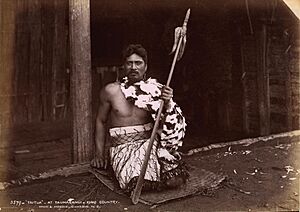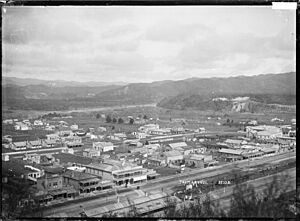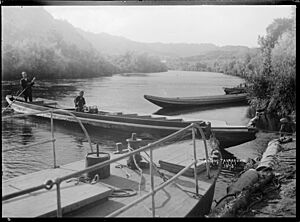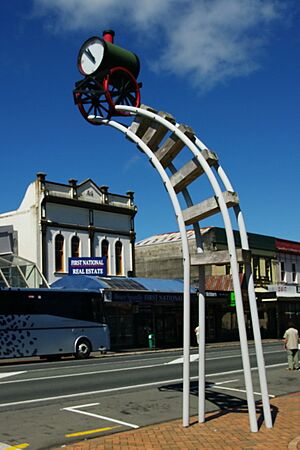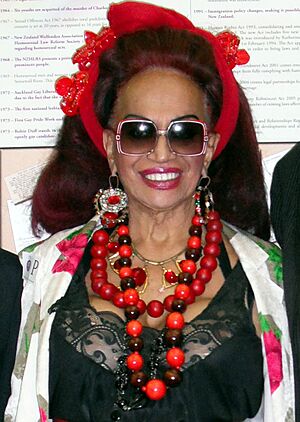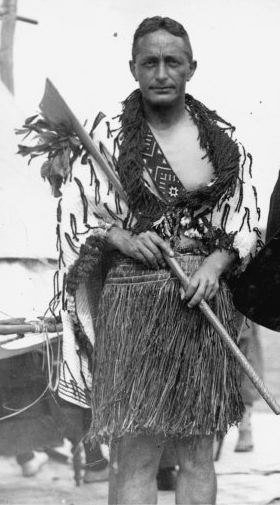Taumarunui facts for kids
Quick facts for kids
Taumarunui
|
|
|---|---|
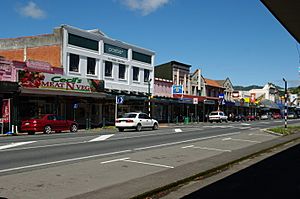
Hakiaha Street in 2009
|
|
| Country | New Zealand |
| Region | Manawatū-Whanganui |
| District | Ruapehu District |
| Ward |
|
| Community | Taumarunui-Ōhura Community |
| Electorates |
|
| Area | |
| • Total | 13.65 km2 (5.27 sq mi) |
| Population
(June 2023)
|
|
| • Total | 4,800 |
| Postcode(s) |
3920
|
| Area code(s) | 07 |
Taumarunui is a small town in the King Country area of New Zealand's central North Island. It sits on a flat plain near the Whanganui River. The town is about 65 km south of Te Kūiti and 55 km west of Tūrangi. It is part of the Ruapehu District and the Manawatū-Whanganui region.
Taumarunui has a population of 4,800 as of June 2023, . It is the biggest town for a long distance around. You can find it on State Highway 4 and the North Island Main Trunk railway line.
Contents
What Does the Name Taumarunui Mean?
The name Taumarunui is thought to come from the last words of the Māori chief Pehi Turoa. Taumaru means screen and nui means big. So, it could mean "Big Screen," perhaps a shelter built for him from the sun. It is also often said to mean "The place of big shelter." Some stories also suggest Taumarunui was a great sheltered spot for growing kūmara (sweet potatoes).
Another idea about the name comes from a 1926 newspaper article. It says the name is linked to a war party from the Whanganui River. This group, led by "Ki Maru," captured a main fort in the 18th century. His warriors called him "Tau-maru-nui," meaning "Maru the Great" or "Maru the Conqueror." This name then became the name for the area.
Where is Taumarunui Located?
South of Taumarunui on State Highway 4 are the villages of Manunui, Piriaka, Kakahi, Ōwhango, Raurimu, and National Park. To the north, you'll find the school and truck stop of Māpiu.
The Story of Taumarunui
Taumarunui began as a Māori settlement. It was located where the Ongarue River meets the Whanganui River. These rivers were important canoe routes. They connected the island's inner areas with settlements further down the Whanganui River. Some places nearby, like the Pungapunga Stream valley, were famous for their large totara trees. Big canoes were built there. This area was a meeting point for different iwi (tribes), including Whanganui, Ngāti Maniapoto, and Ngāti Tūwharetoa. They generally lived together peacefully.
In 1874, Alexander Bell set up a trading post. He became the first European to settle there. Today, there's a road in town called Bell Road.
The Whanganui River was the main way to get to Taumarunui for a long time. At first, people used Māori canoes. By the late 1880s, regular steamship services began. Taumarunui Landing was the last stop for Alexander Hatrick's steamboat service from Wanganui. These river boats ran until the late 1920s.
Taumarunui became even more important when the North Island Main Trunk line was finished in 1908–09. This railway line connects Auckland and Wellington. The section south of Taumarunui was very difficult to build because of the land. It has high bridges and the famous Raurimu Spiral. The Stratford–Okahukura Line also connected just north of Taumarunui.
Today, the town's economy relies on forestry (logging) and farming. It's also becoming a popular place for tourists. Many people start their trips down the beautiful Wanganui River from here. The town also has a great golf course.
Key Moments in Taumarunui's History
1800s
- 1864 – The boundaries of the King Country were set. European settlement was not allowed.
- 1874 – Alexander Bell became the first European settler. He opened a trading post.
- 1883 – Surveys began for the railway route through the King Country.
- 1884 – The ban on European settlement was lifted. Alcohol was still not allowed.
- 1885 – The first post office opened in Taumarunui.
1900–1914
- 1901 – The railway line connecting Te Kūiti to Taumarunui opened.
- 1903 – The railway line passed through Taumarunui. The Taumarunui Railway Station opened.
- 1904 – The first European child was born in the town.
- 1906 – The first issue of the Taumarunui Press newspaper was published.
- 1907 – The first hospital was built with 5 beds.
- 1908–09 – The North Island Main Trunk railway line opened for trains between Auckland and Wellington.
- 1910 – Taumarunui was officially declared a Borough (a type of town).
- 1912 – The town started getting its water supply from Waitea Creek.
1914–1939
- 1915 – The Taumarunui Hospital Board was formed. The hospital now had 30 beds.
- 1924 – The Piriaka Power Station was built to provide electricity to Taumarunui.
- 1932 – The Stratford–Okahukura Line railway was finished.
- 1939 – Hatricks's steamboat service stopped running.
1939–1999

- 1952 – Kaitieke County and Ohura County joined with Taumarunui County.
- 1966 – King Country Radio 1520AM started broadcasting from Taumarunui.
- 1988 – The Taumarunui District Council was formed.
- 1989 – The Taumarunui District Council joined the Ruapehu District Council.
- 1997/98 – The AFFCO Holdings meat processing plant closed.
2000s
- 2005/06 – The Taumarunui Milk Co-op closed.
- 2009 – The Stratford–Okahukura Line railway was put on hold.
- 2010 – King Country Radio went off air.
- 2012 – The Northern Explorer train stopped making passenger stops at Taumarunui Station.
Marae in Taumarunui
A marae is a special meeting place for Māori people. There are several marae in the Taumarunui area. They are connected to local iwi (tribes) and hapū (sub-tribes). Here are some of them:
- Kimihia Marae is linked to Ngāti Te Wera.
- Morero Marae and Hauaroa are linked to Ngāti Hekeawai and the Ngāti Hāua hapū of Ngāti Hāuaroa and Ngāti Reremai.
- Ngāpuwaiwaha Marae and Te Taurawhiri a Hinengākau are linked to the Ngāti Hāua hapū of Ngāti Hāua and Ngāti Hāuaroa.
- Petania Marae and Hinemihi meeting house are linked to the Ngāti Maniapoto hapū of Hinemihi, Parewaeono and Rōrā. They are also linked to the Ngāti Tūwharetoa hapū of Ngāti Hinemihi.
- Takaputiraha Marae is linked to Ngāti Maniapoto.
- Te Peka Marae is linked to the Ngāti Hāua hapū of Ngāti Hekeāwai.
- Tū Whenua Marae and Tū Whenua meeting house are linked to the Ngāti Maniapoto hapū of Mangu, Rewa and Tupu.
- Whānau Maria Marae and Whānau Maria meeting house are linked to the Ngāti Hāua hapū of Ngāti Hāua.
- Wharauroa Marae and Hikurangi meeting house are linked to several hapū. These include Ngāti Maniapoto hapū Hinemihi and Rangatahi. Also Ngāti Hāua hapū like Ngāti Hekeawai, Ngāti Hinewai, Ngāti Hāuaroa, Ngāti Hāua, and Ngāti Wera/Tuwera. And Ngāti Rangatahi.
In October 2020, the government provided money to improve Takaputiraha Marae, Whānau Maria Marae, Wharauroa Marae, and five other nearby marae. This project helped create 156 jobs.
Taumarunui's Population and People
Taumarunui covers an area of 13.65 km2 (5.27 sq mi). Its estimated population is 4800 as of June 2023, . This means there are about 352 people per square kilometer.
In the 2018 New Zealand census, Taumarunui had 4,707 people. This was a small increase from 2013, but a decrease from 2006. There were 1,812 households. The population included 2,307 males and 2,403 females. About 22% of the people were under 15 years old.
The people living in Taumarunui come from different backgrounds. About 60.5% were European/Pākehā, and 52.1% were Māori. Other groups included Pacific peoples (3.3%), Asian (3.5%), and other ethnicities (1.4%). Some people identify with more than one ethnicity. About 9.9% of people were born outside New Zealand.
When asked about religion, 47.9% said they had no religion. 36.1% were Christian, and 5.0% followed Māori religious beliefs.
Taumarunui's Weather
Taumarunui has an Oceanic climate, meaning it has mild temperatures. Because of where it is located, Taumarunui can have warm to hot summers. In winter, it is cold and frosty. The town gets about 1,449 mm (57.047244 in) of rain each year. It also gets around 1822 hours of sunshine annually.
In June 2002, Taumarunui had only 27 hours of sun. This was the lowest amount recorded in the whole country at that time. The coldest temperature ever recorded in Taumarunui was −6.8 °C in July 2010.
| Climate data for Taumarunui (1991–2020 normals, extremes 1947–present) | |||||||||||||
|---|---|---|---|---|---|---|---|---|---|---|---|---|---|
| Month | Jan | Feb | Mar | Apr | May | Jun | Jul | Aug | Sep | Oct | Nov | Dec | Year |
| Record high °C (°F) | 34.0 (93.2) |
33.4 (92.1) |
32.4 (90.3) |
28.3 (82.9) |
23.1 (73.6) |
20.6 (69.1) |
20.0 (68.0) |
21.7 (71.1) |
25.5 (77.9) |
27.8 (82.0) |
30.9 (87.6) |
33.9 (93.0) |
34.0 (93.2) |
| Mean daily maximum °C (°F) | 23.8 (74.8) |
24.2 (75.6) |
22.5 (72.5) |
19.0 (66.2) |
15.5 (59.9) |
12.9 (55.2) |
12.2 (54.0) |
13.6 (56.5) |
15.3 (59.5) |
17.4 (63.3) |
19.6 (67.3) |
22.0 (71.6) |
18.2 (64.7) |
| Daily mean °C (°F) | 17.7 (63.9) |
18.0 (64.4) |
16.2 (61.2) |
13.2 (55.8) |
10.5 (50.9) |
8.1 (46.6) |
7.5 (45.5) |
8.6 (47.5) |
10.3 (50.5) |
12.1 (53.8) |
13.8 (56.8) |
16.2 (61.2) |
12.7 (54.8) |
| Mean daily minimum °C (°F) | 11.5 (52.7) |
11.8 (53.2) |
9.8 (49.6) |
7.4 (45.3) |
5.4 (41.7) |
3.3 (37.9) |
2.8 (37.0) |
3.6 (38.5) |
5.4 (41.7) |
6.8 (44.2) |
7.9 (46.2) |
10.4 (50.7) |
7.2 (44.9) |
| Record low °C (°F) | 0.4 (32.7) |
0.3 (32.5) |
−2.8 (27.0) |
−2.6 (27.3) |
−5.7 (21.7) |
−6.1 (21.0) |
−6.8 (19.8) |
−6.4 (20.5) |
−4.5 (23.9) |
−4.2 (24.4) |
−1.6 (29.1) |
0.7 (33.3) |
−6.8 (19.8) |
| Average rainfall mm (inches) | 107.9 (4.25) |
91.4 (3.60) |
80.6 (3.17) |
119.4 (4.70) |
141.6 (5.57) |
145.4 (5.72) |
156.8 (6.17) |
147.2 (5.80) |
154.8 (6.09) |
144.0 (5.67) |
124.0 (4.88) |
132.6 (5.22) |
1,545.7 (60.84) |
| Mean monthly sunshine hours | 211.8 | 195.0 | 182.6 | 139.7 | 104.3 | 80.4 | 97.3 | 123.7 | 126.5 | 159.8 | 174.2 | 181.7 | 1,777 |
| Source: NIWA | |||||||||||||
Community and Education in Taumarunui
Ngāpuwaiwaha marae is on Taumarunui Street. Its main hapū are Ngāti Hāua and Ngāti Hauaroa. These are part of the iwi Te Āti Haunui-a-Pāpārangi.
Taumarunui has many community groups. These include a Cosmopolitan Club and an RSA. There is also a Lodge of the Freemasons.
Schools in Taumarunui
- Taumarunui High School is a secondary school for students in Years 9 to 13. It has a roll of 278 students as of February 2024.
- Taumarunui Primary School is for students in Years 1 to 8. It has a roll of 135.
- Tarrangower School is for students in Years 1 to 8. It has a roll of 34.
- Turaki School is for students in Years 1 to 8. It has a roll of 168.
- St Patrick's Catholic School is a Catholic primary school for students in Years 1 to 8. It has a roll of 50.
Famous People from Taumarunui
Many notable people have connections to Taumarunui.
People Who Attended Taumarunui High School
- James L. Beck – A professor of Engineering and Applied Science at California Institute of Technology.
- John C. Butcher – An honorary research professor of Mathematics at the University of Auckland.
- Ben Fouhy – A world champion kayaker.
- Marc and Todd Hunter – Members of the band Dragon.
- Ivan Mercep – An award-winning architect.
- Jenny Ludlam – An actress.
People Born in Taumarunui
- 1914 – Wiremu Hakopa Toa Te Āwhitu SM – The first Māori to become a Catholic priest.
- 1922 – Lucy Ruth Miller (Ruth Kirk) – Wife of former Prime Minister Norman Kirk.
- 1934 – Ian Barker – A solicitor, judge, and legal expert.
- 1935 – Don Selwyn – An actor and director from Ngāti Kurī and Te Aupōuri iwi.
- 1939 – David Penny – A theoretical biologist.
- 1945 – Carole Shepheard – An artist.
- 1951 – Joe Karam – A rugby union player and investigator.
- 1952 – Ian Ferguson – An Olympic canoer.
- 1952 – Max Takuira Matthew Mariu SM – The first Māori to become a Catholic bishop.
- 1953 – Marc Hunter – The lead singer of the band Dragon.
- 1955 – Mahinārangi Tocker – A singer.
- 1956 – Len Brown – A former Mayor of Auckland.
- 1958 – Jillian Smith – A field hockey player.
- 1963 – Timothy J. Sinclair – A political scientist.
- 1966 – John Psathas – A composer.
- 1979 – Ben Fouhy – An Olympic and world champion canoeist.
People Honoured for Their Service
Many residents of Taumarunui have received honours for their service to the community and Māori people.
- 1956 – Pateriki Joseph Hura – For his work with the Māori people.
- 1961 – Pei Te Hurinui Jones – For his services to the Māori people.
- 1970 – Eric Raymond Clark – For community service and supporting Māori education.
- 1979 – Hepi Hoani Te Heuheu – For his services to the Māori people and the community.
- 1995 – Alexander Phillips – For his work with the Māori people.
- 2000 – Jean Bassett – For community service.
- 2002 – Barry David FISHER – For his service as Chief Fire Officer of the Taumarunui Volunteer Fire Brigade.
- 2007 – William Vernon McMinn – For his services to music.
- 2009 – Ngarau Tarawa – For services to Māori and community education.
- 2012 – Ian Trevor Corney – For his services to agriculture.
- 2013 – Susan May Morris – For her services to local government.


